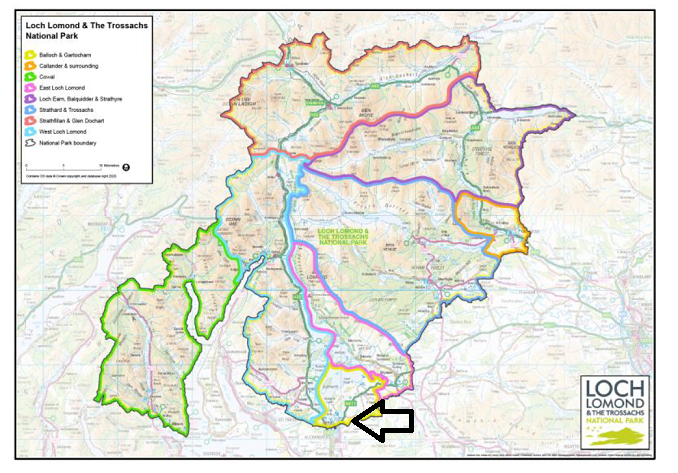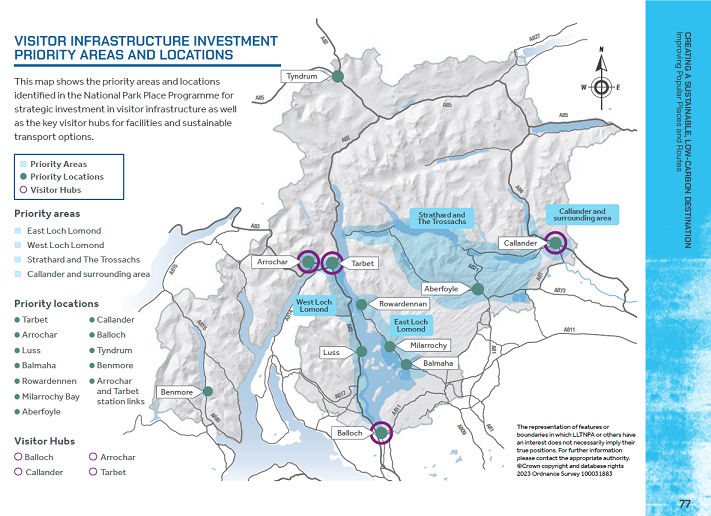After from some excellent objections, no new documents have been added to the Loch Lomond and Trossachs National Park Authority (LLTNPA)’s planning portal (see here) since I wrote two months ago about how Flamingo Land appears to be losing the battle at Balloch (see here). While ostensibly not a lot appears to be happening, two draft plans from the LLTNPA suggests that its senior staff are still trying to pave the way for Flamingo Land to be given the go-ahead at Balloch.
Flamingo Land and the draft National Park Partnership Plan (NPPP)
On 26th April the LLTNPA issued a draft of its new NPPP (2024-2029) for consultation (see here). It contains what might at first appear to be a presumption against major new developments (p105):
“Significant new development is not envisaged to be required beyond that already identified in the current National Park Local Development Plan (LDP) and already in the pipeline for delivery. Development that will meet the strategic needs of the National Park and adjoining areas at Balloch and Callander is still considered necessary, as well as a focus on addressing vacant and derelict sites at Arrochar and Tarbet”.
The LDP 2017-21 did allocate the Riverside Site at Balloch for “Visitor Experience” – not necessarily the same thing as “significant development” – but to describe this as being “already in the pipeline for delivery” is to prejudge Flamingo Land’s current proposals. That is supported by the assertion that the developments at Callander and Balloch are “still considered necessary”. Who still considered them necessary – staff or the Board? – and what work has the LLTNPA done to determine whether the developments, as “envisaged”, are compatible with the new National Planning Framework set out in NPPF4?
Page 115 of the draft NPPP goes on to state:
“Strategic scale development will be supported at Callander, Arrochar, Tarbet and Balloch through………….
» The delivery of tourism investment in Balloch as a core strategic tourism gateway location, with opportunities for improved transport interchange as well as job creation and wider economic regeneration with adjoining areas to the National Park.”
With Scottish Enterprise having signed a new Exclusivity Agreement with Flamingo Land for the development of their land at Balloch, the “delivery of tourism investment at Balloch” would require LLTNPA staff to recommend their Board give the go ahead to the current Planning Application.
A less biased consultation on the NPPP would have asked what changes need to be made to the LLTNPA’s LDP in the light of NPF4 and, more specifically, what are the implications of NPF4 for the sites in the National Park that up until now have been earmarked for major development?
The most recent published objection (dated 16th May) to Flamingo Land’s application includes a summary of the policies contained in NPF4 that it considers “a new development should satisfy:
• To encourage, promote and facilitate development that addresses the global climate emergency and nature crisis.
• To encourage, promote and facilitate development that minimises emissions and adapts to the current and future impacts of climate change.
• To protect biodiversity, reverse biodiversity loss, deliver positive effects from development and strengthen nature networks
• To protect, restore and enhance natural assets making best use of nature based solutions.
• To protect and expand forests, woodland and trees.
• To encourage, promote and facilitate development that is consistent with the waste hierarchy.
• To encourage, promote and facilitate developments that prioritise walking, wheeling, cycling and public transport for everyday travel and reduce the need to travel unsustainably.
• To protect people and places from environmental harm, mitigate risks arising from safety hazards and encourage, promote and facilitate development that improves health and wellbeing
• To encourage, promote and facilitate a new strategic approach to economic development that also provides a practical model for building a wellbeing economy at local, regional and national levels
• To encourage rural economic activity, innovation and diversification whilst ensuring that the distinctive character of the rural area and the service function of small towns, natural assets and cultural heritage are safeguarded and enhanced.
• To encourage, promote and facilitate development which reflects our diverse culture and creativity, and to support our culture and creative industries.”
The objection argues that Flamingo Land’s proposed development DOES NOT satisfy any of the
criteria/requirements of NPF4 and therefore application should be refused.
The LLTNPA clearly has a lot of work to do in assessing Flamingo Land’s revised proposals against NPF4. To this I would add that they need to assess all the land allocated for development in the LDP against NPF4 to determine what if any development might still be appropriate on that land.
As I argued in my last post on Flamingo Land, the crucial issue at Balloch is the scale of the proposed development and how it puts commercial interests before the need for green space, facilities for the local community etc as set out in NPF4. The LLTNPA’s draft NPPP completely fails to acknowledge or address this point and its wording appears designed to allow Flamingo Land’s current proposals to go ahead in their current form.
Flamingo Land and the LLTNPA’s tourism infrastructure plans
LLTNPA staff have prepared two papers about tourism infrastructure for the Board Meeting tomorrow (Monday 12th June), one on a Place Investment Strategy and the second on an Estates Strategy (see here).
A year ago the LLTNPA Board approved a “place programme” which divided the National Park into eight areas, based around visitor management – a welcome resuscitation of the visitor management plans that staff had previously dropped without board approval (see here).

Plans for those areas were to be based on “Strategic Tourism Infrastructure Development” studies, four of which were underway and four of which the Board was told were “in the pipeline”. The latest Board Paper reveals (para 6.10) a “revised approach to the completion of the Strategic Tourism
Infrastructure Studies” and that the studies for those four areas, which include Balloch and Gartocharn, are now on hold::

The justification for this stinks. The paper (see here) claims “Work remains focussed on those areas that experienced the highest level of visitor pressure, particularly in the Covid-19 pandemic: East Loch Lomond, West Loch Lomond and the Trossachs and Callander Area.” Actually, although the NPPP fails to include any facts about tourism and visitors, it is Balloch that receives the highest number of visitors – Loch Lomond Shores was once the second most visited “attraction” in Scotland – and is just as beset with travel chaos as east and west Loch Lomond.
Also pertinent is the fact that part of the solution to the traffic and other visitor pressures along both shores of Loch Lomond lies at Balloch, the gateway to the National Park. The draft NPPPout for consultation actually undermines the case that Stuart Mearns, the Director of Place, makes in his latest place paper when it describes “Balloch as a main visitor and transport interchange hub for the National Park”!
So why is there now no visitor infrastructure study or plan for Balloch? Aside from the lack of joined up thinking by the National Park senior management team, the most likely answer, is that any such plan would throw yet another spanner into Flamingo Land’s revised planning application. That is designed to attract more cars to Balloch (see here) and will do nothing to improve the public transport gaps highlighted in the NPPP:
“A good example of the current system failure is that public transport provision to the rural visitor hotspot destination of Balmaha from Balloch has more capacity on a Tuesday morning in November
than on a Saturday in the peak of the summer.”
Quite! But it appears that enabling the go-ahead to be given to the Flamingo Land development is far more important than tackling these issues.
The LLTNPA – still compromised over the Flamingo Land development
As I understand it, Fiona Logan, the former Chief Executive of the LLTNPA took a trip down to Yorkshire to see Flamingo Land’s resort to look at development ideas for the National Park. While it is not known if Flamingo Land were encouraged to put in a bid for the Riverside Site when it was marketed by Scottish Enterprise, the LLTNPA was on the interview panel that selected them as preferred developer. The LLTNPA then allowed the land it controlled at the pierhead to be included in Flamingo Land’s first planning application which was submitted jointly with Scottish Entrerprise (see here).
The massive public outcry about the application, which highlighted it was contrary to a number of polices in the Local Development Plan, then forced staff to recommend the application be refused. Their grounds, however, for doing this were very limited (the impact on Drumkinnon Woods, the height of the proposed hotel, the historic character of Woodbank House) (see here) which left the door open to a revised application.
The LLTNPA has been far more careful to distance itself from Flamingo Land’s second application which was submitted just over a year ago. The LLTNPA’s own land is no longer included in the development, despite the fact that its own Board has never discussed the matter, and the LLTNPA’s own estate staff have been allowed to submit critical comments about how the proposed development might affect the Duncan Mills slipway. Last Autumn the LLTNPA even published the further information it was seeking from Flamingo Land in the light of NPF4.
Underneath, however, not that much has changed. The LLTNPA has still not published any responses to the application from its own staff on matters such as landscape or woodland – something that is standard practice in the Cairngorms National Park where the planners “adjudicate” between the assessments of developers and of their own staff. Meantime it has also gone very quiet on what is happening to the National Park Gateway Centre at Balloch which in an email dated 16th November 2022 the Park’s Information Manager stated:
“As at the 31st March 2022, the asset remained vacant, but the lease had not been formally terminated. At that time there were no plans to bring the building back into operational use. Similar to the strategic approach to Luss Visitor Centre, the Board have previously instructed officers to explore options to withdraw from the asset, but no formal decision to proceed on this has yet been made”.
The Estates Strategy being considered by the LLTNPA Board tomorrow is silent about the former Gateway Centre at Balloch – perhaps the LLTNPA’s plans have been hidden away in some other paper? The point is that if the Gateway Centre has or is being handed back to Scottish Entreprise that will pave the way for them to offer the asset to Flamingo Land and in turn help them offset the land at Drumkinnon Woods which they have been forced to remove from their proposed development (see here). The fact that none of this is in the open, raises serious concerns about what LLTNPA staff are doing behind the scenes.
The suspension of Balloch from the LLTNPA’s place programme and the way the draft NPPP has continued to promote a major development there needs to be seen in this context and casts further doubt about the impartiality of the whole planning process. The good news is that should the LLTNPA Board ever approve the planning application, it should be possible to challenge the process legally.


Good job on this report. Flamingo land had shown a picture of the land beside the Leven, unused. In the good weather,the place is overflowing with people enjoying themselves.